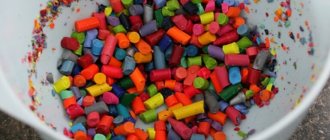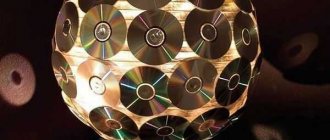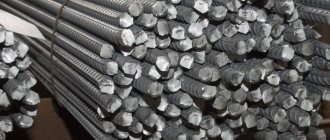Assortment of attachments
The most common products for processing automobile bodies are: sponge-like, abrasive with varying degrees of grain, felt, having a soft surface. They are conventionally classified according to the type of production into two types:
- petal (has high productivity and high price);
- surface grinding (made like a rubber disc with an additional coating for processing).
The material for these items is dense foam rubber or felt, which has different diameters. However, kits are sold that consist of several elements that have different purposes and manufacturing complexity.
How to make a petal disk yourself
Products for inventors Link to the store.
I found the prototype on the Internet, on the “I Build It” website. First we will make a template for the petals. Let's cut a small piece from the finished plinth and transfer its profile to a piece of plywood 4 mm thick. Then we will cut out and sand a template with which we will mark the sheet of sandpaper. Now we will make a drum from this board. But first, let's mark the workpiece. Let's draw a circle with a diameter of 65 mm and divide it into 24 equal parts. Let's draw another circle with a diameter of 55 mm. It will determine the depth of the cuts. Now use a ring drill to cut out two disks and glue them together. The drum is ready. Its thickness is about 0.5 cm.
DIY electronics in a Chinese store.
While the glue dries, let's make the petals. Using the template, mark the sanding paper and cut out the petals of the future disk. Using the markings, we will make shallow radial cuts. Lubricating the flat edge of the petals with “liquid nails” glue, insert it into the drum. The glue had dried by then.
Let's assemble the grinding disc. Insert an M6 screw into it and tighten it with a nut.
Making your own nozzles
If there is no suitable option on sale, then for a disk with a high level of rigidity you can make a soft layer of great thickness and place it between Velcro and a plastic base. Using a utility knife, you need to cut off the Velcro where the soft layer will be glued. For the soft layer, a bath sponge is mainly used. It must be remembered that individual elements can shift, breaking the overall symmetry.
You can also use a felt disc, which is used in a polishing machine and machine. First, you should make a pin with a suitable diametrical size and apply a thread on one side. On this side you need to secure the disk, which is surrounded on both sides by a wide nut and a limit washer. This device is not difficult to manufacture and can be used to process various surfaces.
DIY abrasive wheel.
First, I’ll briefly go through the points, if you don’t change your mind, then I’ll write in detail. I'm afraid I won't manage this evening 
1. Circle - cylinder Approximately f200 x 30 width - maximum. I plan to add a profile later - this is how it is always done.
Yeah that's good. The straight profile is the easiest to manufacture.
that's good. The straight profile is the easiest to manufacture.
Press form. For small volumes, the mold undergoes maintenance for at least 45 units. In case of increasing the volume of the mold, it is advisable to chrome plate it followed by grinding. The durability of the chrome plated mold is approximately 150-200 pressings.
2. I planned to try regular garnet sand, which is sold for sandblasting. In our area it’s not so easy to buy what you need, and it’s cheap.
You need to be careful with the components. If you want to have a predictable result, then it is better to work on one or two types of abrasive. Preferably a factory-made abrasive with the required dispersion and constant chemical composition (a quality certificate is desirable, but not required). It is better to refrain from abrasive, which is shoveled into bags in a nearby quarry. Using the correct basic components (abrasive and bond) will prevent damage to nerve cells in the future. 
3. I don't know. That's why I created the topic. I was thinking of trying some kind of glue - if they suggest, or a polymer melt. The bond should be soft, sand that wood (also soft)
This is ambiguous. The main requirement for the bond is to “correctly” hold the abrasive. Grinding occurs due to wear of the abrasive, and not due to the bond. The bond can enhance or weaken the effect of the abrasive. For example, a tool on ceramics and FFS. The characteristics of the tool are the same. But after grinding with a tool based on FFS, the surface will be cleaner, because... The resin has a slight polishing effect.
I tried an ordinary stone with silicon carbide - green - so it started instantly - and that’s it (((.
Most likely, the circle was solid with low porosity
4. There is a press, What is a thermostat in relation to the situation? Something to heat and control - I have... - a set of heaters of different shapes and an Aries controller for them.
When using a binder that does not require heating (epoxy resin, liquid glass), the question of a thermostat disappears by itself. When using binders made of thermoplastics and thermosets, you will need a stove that allows you to reach a temperature of 200 ° C. When using phenol-formaldehyde resins (bakelite, FFS), the accuracy of maintaining temperature throughout the entire volume of the oven should be plus or minus 2-3 degrees. When using thermosets (FFS), a finished unreinforced circle can be obtained, as a rule, in two ways: cold pressing and hot pressing. In the first case, a sample of the mechanical mixture of components is loaded into a mold and pressed. The workpiece is removed from the mold and placed in an oven for curing. In the second case, a sample of the mixture is loaded into a mold and pressed on a press equipped with heating plates. After a certain time, the finished product is removed from the mold. Having tried hot pressing, I almost immediately abandoned it and completely switched to cold pressing.
5. I have never heard of domestic circles for this purpose, and GOST for them. Imported ones have their own markings, which do not carry any meaning for me like CL CLR CB CS.
Anyway. If there were some initial data, it would be possible to immediately narrow down the search and development circle. But even so you can make some kind of technical specification for yourself. 
6. 5-10 laps every month. Impossible to say as longevity is unknown.
Before starting the conversation here, I talked with sellers of such products. It's difficult to get a clear answer. You need to try and try.
If you seriously want to make circles, then it will take some time to perfect the technology.
Application nuances
A drill attachment for car polishing can be purchased at any store that sells car products. However, you should choose these devices carefully.
Body elements of new cars are made using modern technologies. An anti-corrosion compound and paint are applied to the metal, which are wear-resistant. They will last approximately 15 years. However, this coating is better preserved if it is properly cared for. The polishing device restores the original shine and removes defects from the surface. Together with a special product, such a product will cost less than services provided in a workshop.
Body polishing
The polishing process can correct only some defects. If there is corrosion, chips or damage on the body through which the steel frame is visible, then a major repair will be required.
Before starting the polishing process, you should carefully inspect the vehicle to ensure that any imperfections can be eliminated.
Treatment of the body with a special device will give a positive result if:
- slight difference in shades that resulted after partial coloring;
- the presence of roughness, scratches and cloudy stains;
- faded layer of paint;
- the appearance of graininess and streaks of enamel.
You need to know that you can’t overuse polishing, because when you do it, the paint layer becomes smaller by 5 micrometers. From the date of manufacture of the vehicle, no more than 20 polishing procedures can be performed. At this time, you need to use a thickness gauge, especially if the car is used.
Checking the makeshift disk
Fine dust flies and sands poorly. The paper is too soft. She just strokes the workpiece. The marks from the saw blade remain, albeit slightly smoothed. It turns out that such a disc is not suitable for rough grinding. Let's try using sanding paper on a fabric basis. She's tougher. We will also make the length of the petals shorter. The template profile has also changed a bit. I’ve already done it, because when you touch the part, the petals bend.
I recently became the owner of a band saw. So making cuts in the drum has become much easier. I filled the drum with petals in the same way as before.
Over time, the glue had dried, so to get to the glue that had not dried, I had to cut the tube. Let's check. There are effects. More noticeable than when using the previous disk, but not enough. It will be faster to remove marks from the saw blade manually. Flap sanding discs are used for final sanding. A negative result is also a result. Maybe you can tell me what's wrong.
Using a polishing wheel
By using a polishing wheel on a drill, you can update the appearance of your car. This procedure is most effective if you need to smooth out small chips or remove tarnishing of the surface.
The work is carried out in 2 stages:
- removing paint from the body surface;
- applying polishing compound.
Protective treatment is also carried out to reduce the negative effects of various types of precipitation and ultraviolet radiation. It is mainly done when preparing a car for sale. A protective layer (it contains wax or silicone) is distributed over the surface of the body to form a film that is invisible to the eye, repels moisture, and makes the body shiny. You can polish a used car with a soft pad if there is no paint damage. It can also be used with careful treatment with a protective agent.
Restoring a grinding disc for an angle grinder
As we can see in the photo above, the edge of the disk is very worn and the quality of grinding has deteriorated, and in order to restore it, you need to take an electric sharpener and simultaneously run the sharpener and the disk to grind off the worn part.
This procedure can be performed up to two times on one disk, I checked it personally. After this, the quality of grinding increases.
The first step is to independently separate all the remaining petals from the disk and clean the base.
Next, take a regular piece of sandpaper (ATTENTION! Do not use paper-based sandpaper, only rag-based sandpaper, since paper cannot withstand high speeds)
, apply the disk, trace it and cut it out with scissors.
After that, we make a hole in the middle, apply the emery wheel to the grinding disc and place it on the angle grinder.
After this, you can completely calmly clean the necessary parts and the quality will not be inferior to a regular grinding disc.











